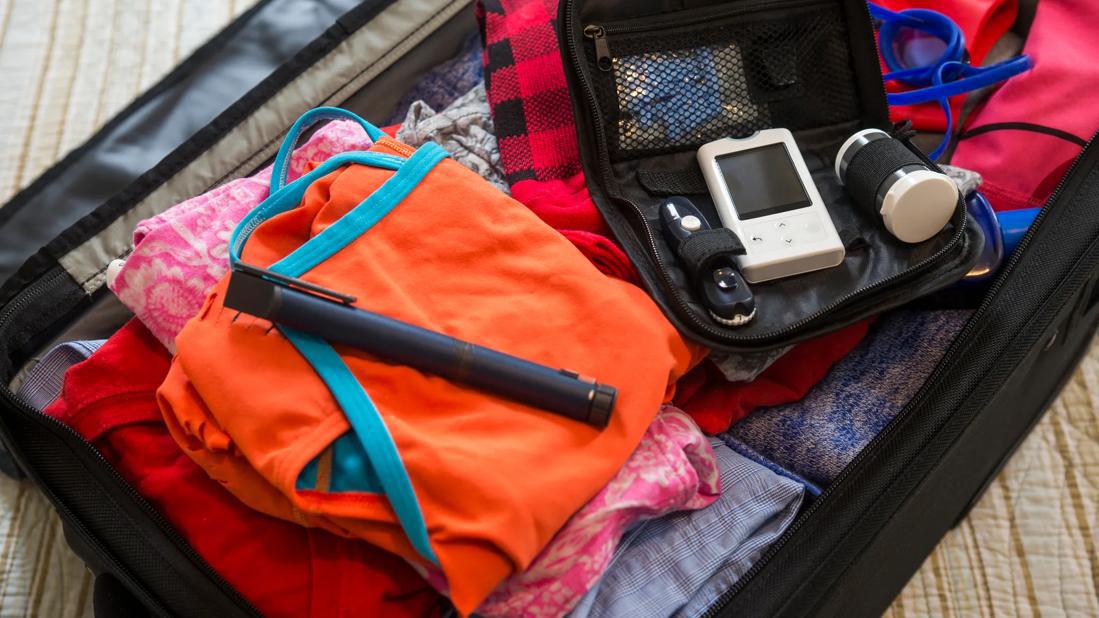Tips for Traveling With Type 2 Diabetes
Pack extra medication and supplies, bring healthy snacks and set reminders

If you’re traveling with Type 2 diabetes, there are some extra considerations you need to take in addition to booking a flight, packing your bags and planning your itinerary. Make sure you have enough medication and supplies for the duration of your trip, pack healthy snacks to eat while traveling and stay hydrated.
Tips for traveling with Type 2 diabetes
Registered dietitian and diabetes educator Emma Rueth, RD, LD, CDCES, offers the following advice for how to prepare for travel with Type 2 diabetes.
Pack extra medication and supplies
In addition to packing enough medication and supplies you need to manage your Type 2 diabetes for your entire trip, it’s a good idea to pack extra in case of travel delays. This may include:
- Insulin pens and needles
- Insulin pump supplies
- Oral diabetes medication
- GLP-1 or dual GLP-1/GIP agonist injectable medication
- Testing supplies like a glucometer and continuous glucose monitor (CGM) replacement sensors
“If you take a medication that puts you at risk for low blood sugar (hypoglycemia), consider bringing glucose tablets,” says Rueth. “Treat blood sugar under 70 mg/dL with 15 grams of carbohydrates, like four glucose tablets or 4 ounces of juice or regular soda.”
And it’s best to pack your medication and supplies in your carry-on luggage if you’re traveling by plane. (An important note: People with diabetes don’t have to follow the TSA’s 3.4-ounce liquid rule.)
Consider wearing a medical ID bracelet
It can also be helpful to wear a medical ID bracelet when traveling with Type 2 diabetes. They typically contain vital information on your medical condition, medications and any allergies. Wearing one can offer you peace of mind in the event of an emergency.
You may also want to carry a letter from your healthcare provider that outlines your medical condition and any medications you take. Or you can print and carry a TSA Disability Notification Card.
And if you’re flying, you can alert TSA workers if you’re wearing an insulin pump or CGM before you go through security.
Think ahead with snacks and meals
It’s especially important to prepare and pack snacks when traveling with Type 2 diabetes.
Consider options — like carrots and hummus — that you can reach for when you feel hungry. If you’re having a meal on the road or at the airport, look for food court options such as fresh fruit, nuts or a salad with grilled chicken.
And you can enjoy the local cuisine when you reach your destination. Rueth adds that it’s important to keep track of your blood sugar so you can make any necessary adjustments.
Don’t forget to drink water
Make sure you stay hydrated as you travel, particularly in hotter environments.
“You can become dehydrated more easily if your blood sugar is uncontrolled,” stresses Rueth.
Think about bringing a reusable water bottle along for your journey and make a priority to drink water during long flights, as well as before, during and after activities.
Wear comfortable clothes and shoes
Opt to wear clothing and shoes that are breathable and comfortable — especially if you’re on a long flight or road trip. Rueth says you may also want to avoid wearing open-toed shoes if your hemoglobin A1C is above 7%.
“If you get a cut, the risk of an infection is higher,” she warns. “Type 2 diabetes may affect your body’s ability to heal.”
Stay on top of your medication
Traveling — especially to a different time zone — can cause jet lag and throw you off your schedule.
Use your phone to set an alarm or reminder for when you need to take your medication or test your blood sugar levels.
Bottom line?
“Don’t let Type 2 diabetes stop you from traveling,” Rueth encourages.
With a little planning, you can have fun and stay healthy. If you have any questions about managing your Type 2 diabetes while traveling, don’t hesitate to talk to your healthcare provider.